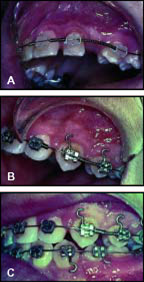Occasionally an open-coil spring is not long enough to open the entire space needed for alignment of a displaced tooth, such as a lingually locked premolar or a canine in buccoversion. In such a case, the base archwire and coil spring are usually removed so that a new, longer spring can be placed.
This time-consuming process can be avoided simply by placing several 1 1/2-2mm lengths of closed-coil spring, of the same wire dimension and lumen as the open-coil spring, over the base archwire in the interbracket space adjacent to the tooth being moved (Fig. A). The open-coil spring is reactivated by removing a single ligature tie and then sliding a section of closed-coil spring across the bracket, thus recompressing the open coil (Fig. B). The procedure can be repeated as many times as necessary by sliding additional lengths of closedcoil spring across the bracket, until adequate space is obtained. There is no need to remove the archwire (Fig. C).
Another simple method of recompressing an open-coil spring whose activation has been fully expressed is to spread the coils apart by squeezing the tips of a lightwire plier between adjacent helices. If this is done several times along the coil, the result is an effective increase in the resting length of the spring.
Similar articles from the archive:



